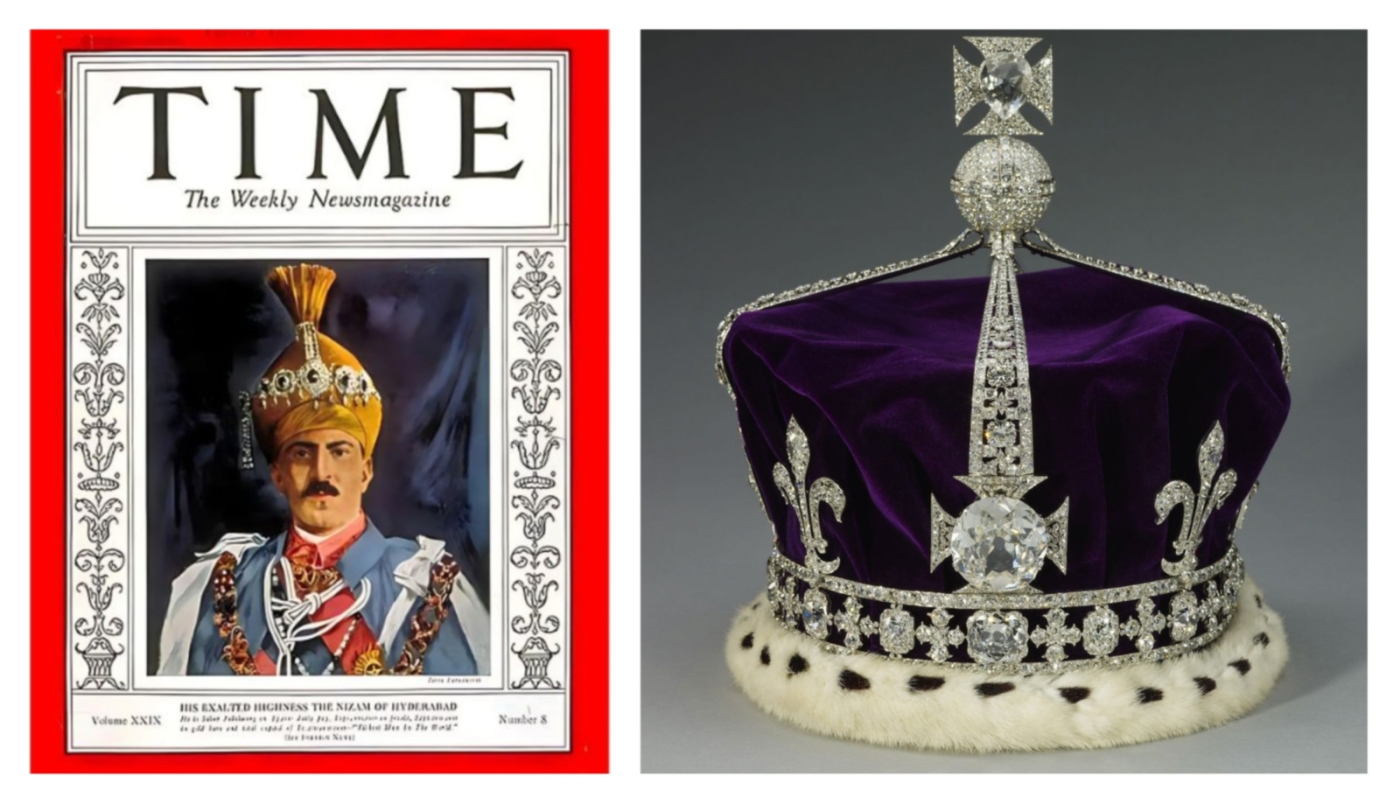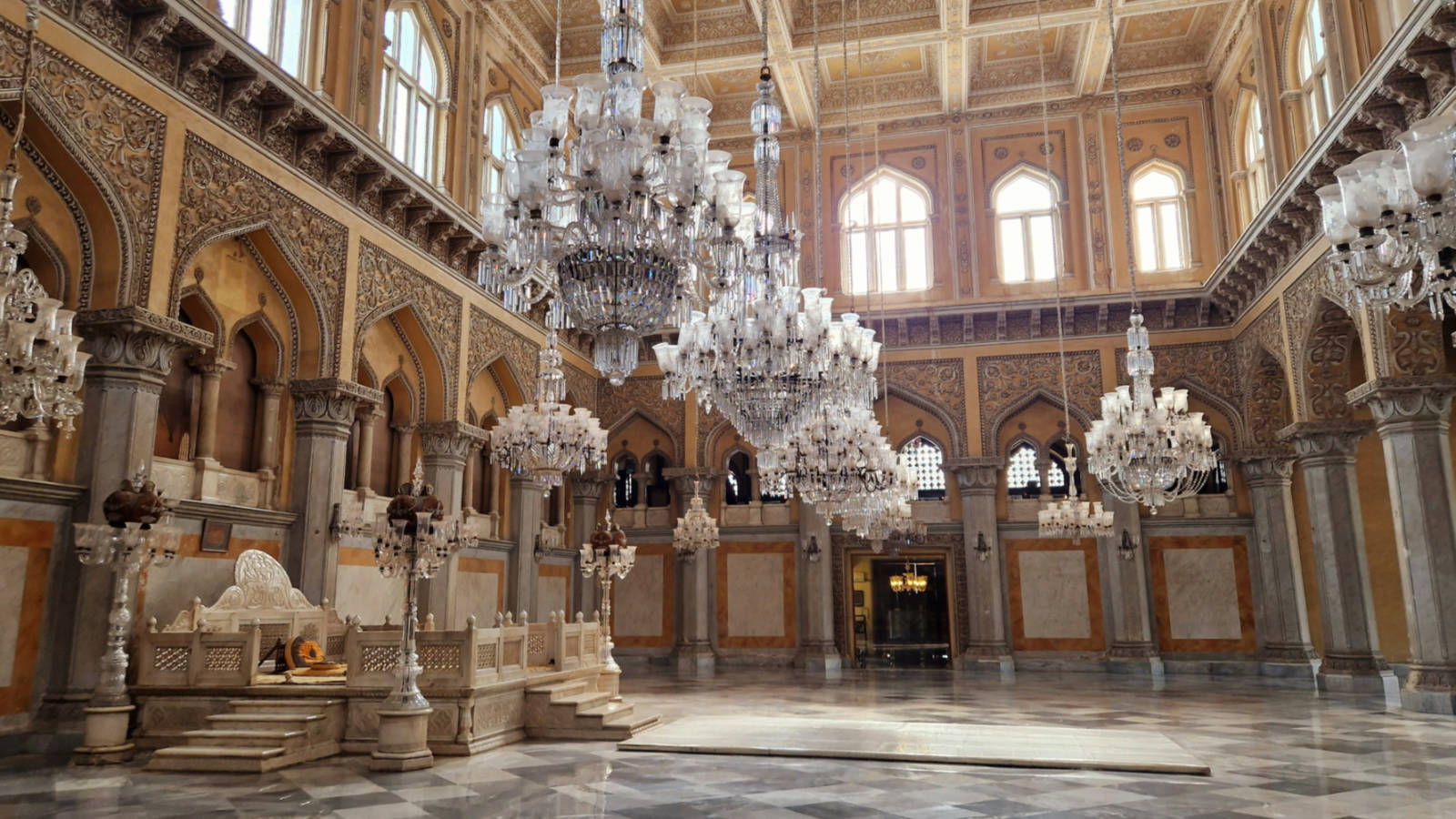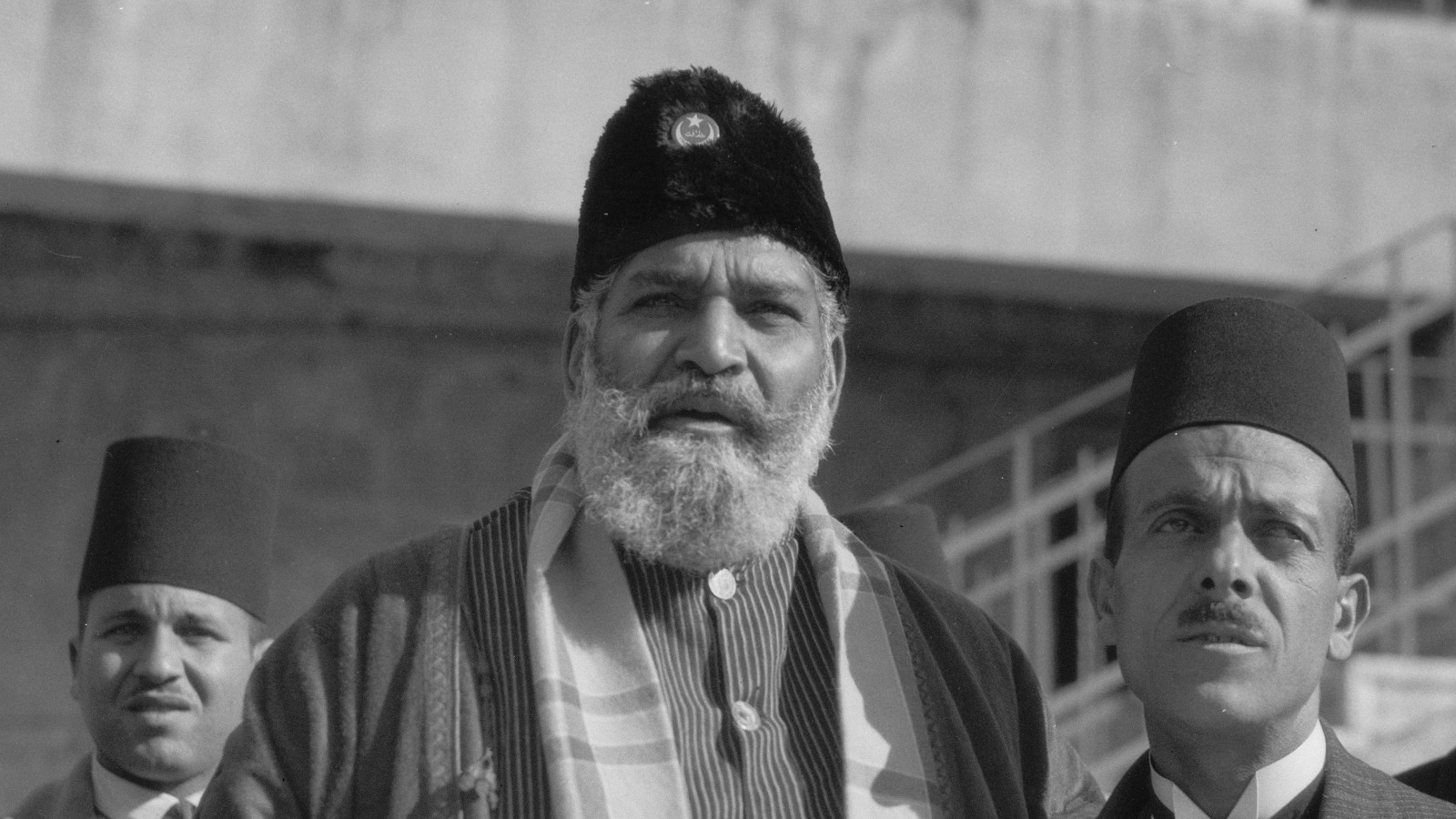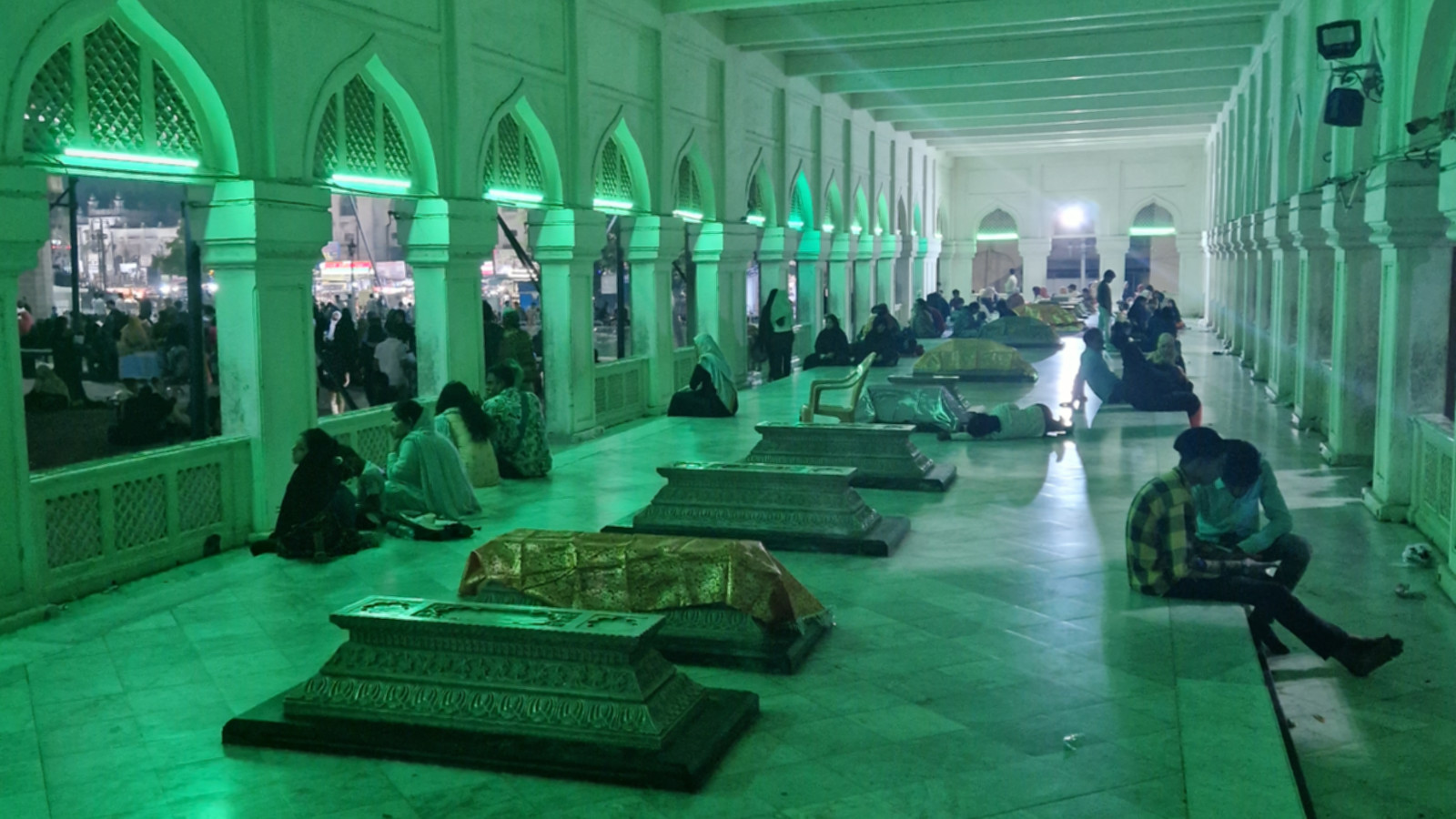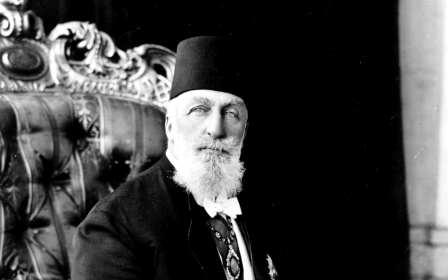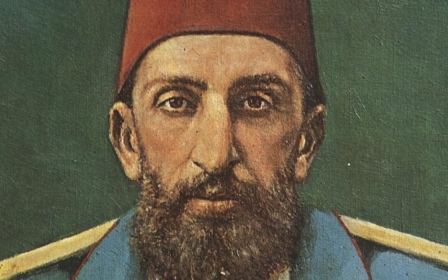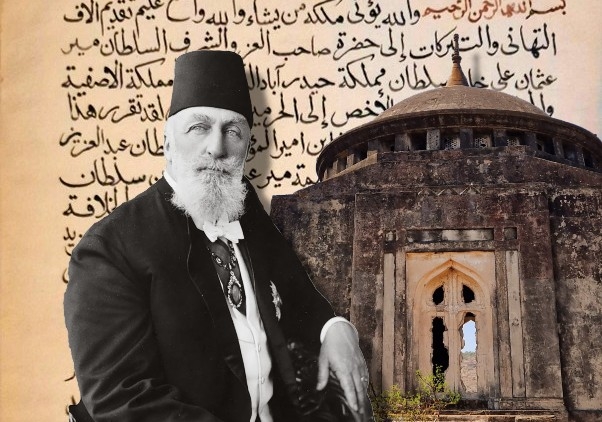
Revealed: Why there is an abandoned Ottoman tomb in remote India
It was mid-morning but already 40 degrees Celsius in the shade when the driver stopped his taxi and refused to go on any further. “The car can’t go on,” he said. “There's no road.”
Around us the terrain stretched out, rocky and uneven. We were in Aurangabad, a district in India’s western state of Maharashtra, and had left any semblance of a road half a mile behind us. My travelling companion James and I looked at each other.
We agreed: we would have to leave the car and walk the rest of the way on foot.
Twenty minutes later we found ourselves in the wilderness. There was no sign of life ahead, neither human nor animal, including sloth bears, which have a reputation for aggression and attacking people.
To the right, the treeline curved away into the distance, while to the left a dusty series of plateaus dominated the horizon. The sun beat down. We were low on water.
New MEE newsletter: Jerusalem Dispatch
Sign up to get the latest insights and analysis on Israel-Palestine, alongside Turkey Unpacked and other MEE newsletters
And then it appeared, small at first, in the distance on a plateau, but unmistakable: an Ottoman mausoleum, around 15 metres tall and eight metres wide, with a large Turkish-style dome on top, latticed windows and archways on all four sides.
Up close, it was possible to distinguish the remains of a complex built around the mausoleum. The grey structure itself was tired and battered, although it still exuded a certain imperial grandeur.
Inside, it was derelict. Walls were scrawled with graffiti, inane scribblings, and the names of lovers drawn to the building for its isolation. Plaster, crumbled from the lower walls, was scattered across the bare floor. Melancholy and mystique hung around the building.
At its centre, a small sunken pit marked where a grave should have been. It was empty.
Why was there an abandoned Turkish-style tomb in the wilderness of western India?
Abdulmecid II: a caliph in exile
Trying to answer this was why we found ourselves in India in the first place.
The man who hoped to be buried in that mausoleum was one of the early 20th century’s most extraordinary and paradoxical figures: a talented painter, Francophile, literary critic, classical music enthusiast - and, most importantly holder of the title caliph, representing Islam’s religious-political succession to the Prophet Muhammad.
Caliph Abdulmecid II was the final nominal ruler of the Islamic world, a member of the House of Osman, the Ottoman dynasty, which had governed swathes of Europe, Asia, and Africa for five centuries.
Born and raised in Istanbul, the centre of Ottoman power, in 1868, Abdulmecid styled himself a “democrat prince” and supported the empire becoming a constitutional monarchy.
Others agreed. “Under the right circumstances and in a calm and prosperous country,” the French magazine L’Illustration informed its readers in December 2022, “Abdulmecid would have been a Turkish Francois I, and the court of the caliph of Constantinople, like that of the caliphs of Cordoba, would have become a new centre of Islamic art.”
But after the First World War, the imperial edifice collapsed. By the time Abdulmecid II was installed on the throne in November 1922, a new Turkish state was being forged from its ashes, and he became the first - and only - caliph of modern Turkey.
His destiny was exile: on 3 March 1924, the Turkish Republic abolished Abdulmecid’s title and bundled him and his family onto the Orient Express, headed for Switzerland.
When the caliph heard of the deposition order, he refused to go. But the republican troops, who surrounded the Dolmabahce Palace on the European banks of the Bosporus, made it clear: go he must.
As he left his home for the final time, Abdulmecid vowed he would always pray for the welfare of Turkey’s people: “And be sure, even dead in my grave, my bones will carry on praying.”
The demise of the 1,300-year-old caliphate shocked the Islamic world. Indian Muslim intellectual Ameer Ali proclaimed it a disaster for both Islam and wider civilization that would “cause the disintegration of Islam as a moral force”.
In London, The Times wrote that in an age of dynastic downfall and the emergence of new ideas, “no single change is more striking to the imagination than is this: and few, perhaps, may prove so important in their ultimate results”.
Yet what happened to the caliph has been largely ignored by historians. Bits and pieces can be found, scattered across books covering disparate disciplines, but the full, extraordinary story has been forgotten.
And when I first read about Abdulmecid in late 2022, I was fascinated and curious, not least about his fate in exile. It was hard to believe that he accepted his expulsion from Turkey.
I spent months investigating and began to uncover an ambitious and ultimately failed plan to resurrect the caliphate - a plan that spanned the Islamic world.
The origin of the plan came only a week into Abdulmecid’s exile in Switzerland, when he issued a proclamation from his hotel, arguing that it was for the Muslim world to “pass with full authority and in complete liberty” upon the question of the caliphate. His declaration was ground-breaking, suggesting a new type of caliphate dependent not on an empire for its legitimacy but on voluntary support from the world's Muslims.
But for it to work, he would need powerful backing.
Wanted: Cause for Muslim billionaire
In the 1930s, Mir Osman Ali Khan was, according to TIME magazine, the world's richest man. The seventh nizam, or ruler, of Hyderabad State, India’s largest and fastest modernising princely state under indirect British rule, he employed 12,000 palace servants and had his own whisky distillery. He also used a £50m diamond as a paperweight.
The nizam’s wealth came from the state’s Golconda mines, from where came the Koh-i-Noor, part of the Crown Jewels of the British monarchy and whose return India has demanded in recent years.
But the nizam was also known for his personal austerity, giving out dinner invitations on scraps of paper torn from old envelopes. “Money has no meaning for him," Hyderabad's finance minister Sir Akbar Hydari said admiringly, "although he knows how to manage it well".
The state had been overseen since the early 18th century by a succession of nizams, short for nizam al-mulk, which means “administrator of the kingdom” in Persian, for centuries one of India’s courtly and literary languages.
During this period, known as the Asaf Jahi era, Hyderabad was a cultural and intellectual hub of the Islamic world, fostering strong links with the Middle East, including Palestine, which itself was part of the Ottoman Empire until the early 20th century.
Governing a largely Hindu population, Khan had a reputation as a tolerant and highly cultured ruler. But it was all to end when the post-independence republic of India invaded in September 1948 and some 40,000 Muslims - according to a conservative estimate - were massacred.
Back in 1924, the caliphal family moved from Switzerland to Nice on the French Riviera that October and settled in the Palais Carabacel, a 19th-century villa. The rent was paid by the nizam, now keen to boost his standing in the Islamic world by visibly supporting the Ottomans.
To learn all this, I studied Ottoman eyewitness accounts of Abdulmecid’s exile in France and spent hours in the British Library in London, itself an enduring product of the British empire. There I trawled through hundreds of pages of unpublished documents brought from Hyderabad to England when the British left India.
I found myself leafing through scores of letters, many marked as confidential, sent between the nizam, Hyderabadi and British officials and the Ottoman exiles. Pieced together, they told how, in 1931, a marriage union was formed between Hyderabad’s Asaf Jahi dynasty and the exiled Ottomans.
Its broker was Maulana Shaukat Ali, a legend of India’s early independence movement, close ally of Gandhi, and former leader of its Caliphate movement, which had lobbied on behalf of the Ottomans after the First World War.
The key to this alliance was the caliph’s daughter, the highly cultivated Princess Durrushehvar. Born at the Camlica Palace in Istanbul in 1914, as a child she learned English, French, Persian, and Arabic as well as Turkish. In exile on the French Riviera she studied music, went riding, and played tennis, all the while submitting essays to French literary magazines. Throughout her life, the princess was captured by acclaimed photographer Cecil Beaton several times.
It is well known that on 12 November 1931 in Nice, the princess, still only 17, married Prince Azam Jah, the nizam’s eldest son and his heir apparent, intimately tying the Ottomans to the world’s wealthiest Muslim family.
But the more I read, the more it became apparent that everyone, from the Turkish government in Istanbul to the Urdu press in Bombay, and from English visitors in Hyderabad to American journalists in Nice understood there was more to the marital union than met the eye: its political potential.
The archives revealed that the Turkish government warned the British before the marriage took place that a “caliphate intrigue” was afoot, something which London realised only too late. In Delhi, Sir Charles Watson, a British political secretary, wrote: “There are obvious inconveniences in the existence at the Hyderabad court of a princess of the former Imperial Ottoman family… inconvenience certainly social and possibly political.”
Days before the wedding, TIME magazine reported: “Should these young people wed and have a man child, temporal and spiritual strains would richly blend in him. He could be proclaimed 'the True Caliph'."
Mukarram Jah: the baby who united dynasties
In 1933, less than two years after the wedding, Princess Durrushehvar returned from India to Nice to give birth to Prince Mukarram Jah, the grandson of both the caliph and the nizam.
Jah was brought up in India: little was said publicly during his childhood about his unique position. But 20 years ago, Australian author John Zubrzycki discovered a remarkable letter in the British Library archives, which he mentioned in The Last Nizam, his biography of the prince.
I pored through bundles of documents for the letter until I found it buried in a weighty file, a scrap of paper marked “confidential”. It was written in November 1944 by Sir Arthur Lothian, Britain’s political resident in Hyderabad, three months after Abdulmecid had died in Paris.
In this bombshell dispatch, Lothian disclosed to his superiors in Delhi that he had discovered the nizam was withholding information from the British about the late caliph’s will. He reported that the president of the nizam’s executive council had told him that Abdulmecid, as one of his final wishes, had asked to be buried in Hyderabad.
There was more: Lothian also wrote that the nizam had omitted to mention that, in the will, Abdulmecid named his grandson Mukarram Jah as successor to the caliphate.
This was incredible: it suggested that the deposed caliph had privately planned to resurrect the Ottoman caliphate in the Indian subcontinent through his grandson - and that the nizam, the world’s richest man, was in agreement.
The British government took no action, which is not surprising: London expected to pull out of India imminently and did so less than three years later. On 15 August 1947, Hyderabad declared its independence on the same day as the rest of India. The new republic refused to accept the nizam controlling a giant state in the middle of its territory and eventually invaded.
But what if Partition had not occurred, and India instead became a federation - an option that was on the table as late as 1946? Hyderabad could plausibly have become an autonomous and modernising princely state.
Prince Mukarram Jah, as nizam, could have claimed the caliphate as his birthright, with a huge impact on global politics, including the potential to transform the Islamic world.
A caliphate in the Indian subcontinent might have risked religious conflict. But the nizam would not rule outside Hyderabad, and Asaf Jahi rule usually amounted to tolerant pluralism.
An Indian caliphate could have made Hyderabad a focal point of the Islamic world, enhancing the Indian subcontinent’s importance to Muslims. But all that never happened.
By now I was keen for any detail, however small, about the events of decades ago. And then in January 2024, I saw it in the Hyderabadi press: a report about Imam ul-Mulk IV, Nawab Syed Ahmed Khan (the word "nawab" indicates a hereditary lord), who said he possessed a deed signed by Caliph Abdulmecid.
I contacted Syed Ahmed Khan: he had read one of my previous articles, which referenced the British Library letter and told some of the story. Did I want to come to India, at the invitation of his family, to research further?
I agreed, on the understanding that I could write whatever I wanted as an impartial researcher. With me would travel James Wrathall, a friend with a keen interest in Islamic history who studied old Arabic and Urdu texts at Cambridge.
Inside the palaces of Hyderabad
Hyderabad City in 2024 is one of India’s largest cities and the capital of the state of Telangana. One side, which the locals call “Cyberabad”, boasts wide roads, flashy restaurants, and an endless stretch of high-rises displaying the logos of nearly every major international technology company.
But until the mid-20th century, it was the capital of the lineage of the nizam. Six of these princes lie buried, side by side, in the Mecca Masjid, the largest mosque of the Old City, which is packed every day with people praying, socialising, and sleeping among the tombstones.
Throughout the neighbourhood, amid a mass of perfume shops, biryani restaurants, and tea vendors, historical artefacts are hidden in plain sight.
In a small inconspicuous museum of ornate hookah pipes and paintings from the nizam’s era lies the sword of Caliph Abdulmecid himself, a magnificent instrument curved in Ottoman fashion and set with a golden handle. Mukarram Jah, heir to the caliphate, held the sword on his accession to the ceremonial title of nizam in 1967. These days, most visitors walk past without a glance.
Some of the stately residences are crumbling, such as the King Kothi Palace, where Mir Osman Ali Khan lived. Others have fared better: the Chowmahalla Palace, which hosted ceremonies of state, is now a museum and still boasts its refined Indo-Islamic architecture, including vaulted arches, towers and turrets.
In the palace’s grand Durbar Hall, the nizam would sit cross-legged on a white marble throne, surrounded by his sons. Noblemen and courtiers dressed in silks and brocades paid homage, as armed Arab guards and the women of the court looked on. One side of the great hall opens onto a Mughal garden, once flanked by cypresses and palms. Today, the fountains no longer run.
In contrast, the Falaknuma Palace has become a luxury hotel, populated by India’s wealthy elite. Built in 1880, it mixes a European Palladian style with Indo-Islamic twists, exemplifying the dizzyingly cosmopolitan and paradoxical world of elite Hyderabad in the late Asaf Jahi era.
Past the stairs lined with naked Greek goddesses is the throne room, which was frequently used for ballroom dancing. Beyond is the banquet hall, home to a 101-foot long dining table that can seat more than 100 guests. The nizam was notorious for throwing unusual dinner parties, serving champagne to the guests of whom he was fond, while others only received non-alcoholic gingerade.
These palaces are now the ruins of a fallen civilisation. Yet some of that world’s cultural heritage still lives - and so does its memory.
While in Hyderabad, we stayed as guests at the Rahnuma-E-Deccan, the Old City residence of the aristocratic Imam ul-Mulk family, which still publishes The Rahnuma Daily, India’s longest-running Urdu daily, formerly patronised by the nizam. The head of the household, born in 1942, is Nawab Akram Abbas Syed and father to Syed Ahmed Khan, who arranged my stay: his father in turn was Colonel Syed Mohammed Amiruddin Khan, the Khan’s military secretary and a close confidante.
Syed has a short white beard and sharp eyes. With a purposeful gait and dignified - almost regal - posture, he speaks in the elegant and cultivated English of the Indian upper echelons, albeit with a subtle twang picked up from his time in Canada.
One evening Syed told us how his father was informed during the 1940s that Prince Azam Jah - Hyderabad’s heir apparent - would not become the next ruler; nor would Azam’s younger brother Prince Moazzam, who had married another Ottoman princess, Durrushehvar’s cousin Princess Niloufer.
Instead, the succession would pass to Prince Mukarram Jah: both the boy’s father and uncle had been rubbed out in the line of succession in favour of a child. “The reason why Azam Jah was not given the successorship was because of his flamboyancy, and Moazzam Jah also had that flamboyancy,” the nawab told us.
He said Moazzam Jah would call the elite of Hyderabad, including his parents, to fancy dress parties, and would have elite women sit and sing for him. Azam Jah would also have concubines dressed in riding breeches, and second the military secretary to chaperone them. “I remember I did ride with the concubines, and I was about 18, 19,” the nawab, now 82, said.
He recalled going with his father, as a teenager, to see Princess Durrushehvar. “She was a very beautiful lady, she was always dressed in a sari and the sari would come over her head. Durrushehvar would stand there and say how the nizam was, and how the successorship would be coming to Mukarram Jah.”
Years later, Amiruddin was to become an advisor to the next generation and was consulted on the succession of Mukarram Jah. And it was among the papers of the colonel, who died in 2012 at 99, that the nawab’s son Nawab Syed Ahmed Khan found a document confirming all that I had so far uncovered.
The colonel's papers included a collection of unpublished handwritten poems by the seventh nizam, as well as a volume of handwritten poetry by his son Azam Jah - and letters from Islamic scholars in Mecca and Medina commending the nizam as a Muslim leader.
One of the documents was an Arabic deed.
Khan told us he had no idea of what the deed, discovered in December 2021, declared - until in early 2023 he showed his grandfather’s papers to prominent academic Dr Syed Abdul Mohaimin Quadri. “I was looking for help to better understand them, and it was during that visit that I learned of their historical importance.”
Quadri works from his cramped library, found within the shrine complex of a locally revered saint, Hazrat Pathar Wali Sahib, in the Old City.
The space is dominated by a collection of manuscripts, including innumerable rare Urdu books and over 600 centuries-old Persian and Arabic manuscripts.
A bearded scholar, complete with traditional skullcap and kurta, he presents a serene and highly learned figure, with a deep commitment to his preservation work. During our visit, he received an almost constant stream of visitors, all of whom greeted him with reverence (the state of Telangana’s home minister had recently dropped by, I was told).
Quadri was excited by the caliphal deed. “It is authentic,” he told us confidently.
The deed was addressed to the nizam and signed by Abdulmecid in Nice on 19 November 1931 - a week after his daughter’s wedding. Through the document, which James translated into English, Abdulmecid transfers the title of caliph to the nizam to hold in trust on his death, before it is claimed by the first-born son from the dynastic union.
“I trust that the firstborn son of this new kinship after you [the nizam] be suitable to the position of the caliphate and the rulership of Hyderabad Deccan," the deed concludes.
I held the deed and looked at it in awe. It was made of thick wheat paper, worn but intact. The ornately formed Arabic words were inscribed in carbon black ink - apart from the caliph’s elaborate signature, which was a bold red. Here was the missing piece in the puzzle, the document which proved Abdulmecid’s closely guarded ambition to have the caliphal line continue in Hyderabad.
Abdulmecid II: Read a translation of the caliphal deed
+ Show - HideThe following is a translation of the caliphal deed of Abdulmecid II. It has been translated into English by James Wrathall. An image of the deed follows below.
"In the name of God the Compassionate the Merciful, and God gives His kingdom to whom He wills and God is All-Encompassing, Knowing. We offer thousands of congratulations and well-wishes to His Highness, Possessor of Splendour and Nobility, Sultan Mir Osman Ali Khan, Sultan of the Kingdom of Hyderabad Deccan, Governor of the Asafi Kingdom, Governor and Ruler of it all, especially as far as the Two Noble Sanctuaries. It has been established that I, Caliph Abdulmecid II, son of Commander of the Believers Sultan Abdulaziz, elect the Possessor of the State and Greatness, Mir Osman Ali Khan, Sultan of Hyderabad Deccan, may God eternalise his Kingdom and Sultanate, to the position of the Caliphate. Indeed this position fell to my most elevated grandfather Sultan Selim Shah son of Bayazid Khan, and the Abbasid Caliph al-Mutawakkil 'ala Allah III gave him it. Indeed the Sultan of the Deccan shall be Commander of the Faithful.
"And I beseech God, splendid and glorious is He, that He grant victory to all the People of the Two Sanctuaries and the People of Islam and I trust that the firstborn son of this new kinship after you be suitable to the position of the Caliphate and the Sultanhood of Hyderabad in the Deccan."
For Khan, the find likewise filled him with wonder. “I realised I had uncovered the greatest mystery of a much coveted and cultural treasure.”
The Imam ul-Mulk family has no political agenda, no intentions for the document, despite what it proves. “Our custodianship of the deed is cultural, historical and apolitical,” Khan said, “with no ambitions for the caliphate's political revival.”
The ties between the Imam ul-Mulk family and the Middle East run deep.
The residence has hosted everyone from the imams of the Holy Mosque in Mecca and the Prophet’s mosque in Medina to the imam of al-Azhar in Egypt, one of the Islamic world’s most prestigious seminaries.
The family also has a long-standing connection to Palestine: its late head, Imam ul-Mulk III, hosted Yasser Arafat in Hyderabad twice. In 1998 the Grand Mufti of Jerusalem laid the foundation stone of a mosque in Hyderabad's Banjara Hills, one of the city’s wealthiest neighbourhoods.
And so it was in 1931, weeks after the dynastic marriages in France, that Maulana Shaukat Ali, who had brokered the unions, headed to Palestine to attend the World Islamic Congress, which he had organised with the grand mufti of Jerusalem.
There, he and Abdulmecid hoped to use the congress to mobilise support among the gathered notables and future Islamic political leaders for the Ottoman caliphal claim.
They failed: as the congress drew near, the British announced they would deny the deposed caliph entry to Palestine.
Abdulmecid’s ambition did not come to pass. But the event did achieve one thing with far-reaching consequences: establishing the Palestinian struggle as a global Islamic and Arab cause.
Caliph's wish is thwarted
Abdulmecid died of a heart attack in 1944, close to Paris’ Bois de Boulogne, amid a firefight between US and Nazi soldiers during the city’s liberation from German forces.
But the world had changed too much for the nizam to grant him his wish of a burial in India.
Aurangabad, where I found that abandoned mausoleum, is now part of Maharashtra, but it used to be in Hyderabad State. Among the region's intellectuals, it is well known that an Ottoman mausoleum had been built for Abdulmecid by the nizam in the early 1940s.
But in 1944, according to private correspondences in the British Library, the nizam considered it unwise, given the growing communal tensions between Hindus and Muslims across India, to have the caliph’s body brought to India, where his daughter lived and where Mukarram Jah, his heir, was raised. Likewise, the government in Turkey prohibited that he be laid to rest in the land of his ancestors.
Instead, Abdulmecid was interred in Paris for nearly a decade before finally being buried in Medina, the Prophet’s city, in Saudi Arabia in 1954. And his abandoned mausoleum, like his letters and will, became another relic from a lost world of possibilities.
Mukarram Jah, heir to both the nizam and the caliph, moved to England in 1948 after Hyderabad fell, where he attended the elite Harrow School, Cambridge University and the Royal Military College at Sandhurst, much like any upper-class English gentleman.
In 1954, his parents, who had another son in 1939, Prince Muffakham Jah, divorced after 23 years of marriage. While Azam Jah died in 1970, Durrushehvar lived in London until her death in 2006 at 92. The princess was buried in Brookwood Cemetery, just south-west of London: she rejected being buried in Turkey because the government in Ankara refused permission for her father to be interred there 62 years earlier.
Mukarram Jah succeeded his grandfather as nizam on his death in 1967 but was in no position to claim the title of caliph from Abdulmecid: with no power, he instead faced a legally disputed inheritance, claimed by thousands of people. In 1971, the Indian government abolished his title of nizam and subjected his property, including the Chowmahalla and Falaknuma palaces, to taxes and land acts.
So Mukarram Jah opted for an unconventional solution, moving to western Australia in 1973, where he bought a 200,000-hectare sheep farm. Jah once told a journalist that Abu Bakr, Islam’s first caliph, had been a shepherd. “I see no reason why I shouldn’t be one,” he added.
In 1996 Jah, by then in his sixties, moved to Istanbul, where his grandfather once held power. There, the heir to the Ottoman caliphate took up residence in a small apartment in the former Ottoman capital, and lived in relative anonymity for the rest of his life.
In January 2023, Nawab Syed Ahmed Khan asked his elder brother, who was travelling to Turkey, to track down Mukarram Jah and tell him about the caliphal deed. “Unfortunately, Jah passed away before my brother could locate him,” he told me.
In death, Mukarram Jah, the eighth nizam, achieved what his maternal grandfather could not and is buried in India, at the Mecca Masjid in Hyderabad. His eldest son Prince Azmet Jah, who has become the ninth nizam, is a British filmmaker: he owns multiple palaces in Hyderabad, including the Chowmahalla and the Falaknuma.
The tale of the Indian caliphate that never was might seem to be a tale of three worlds that collapsed and crumbled away, of the Ottoman empire, the British empire and an Indian state run by princes.
But it was also an important attempt after the fall of the Ottoman empire to imagine a new political future for Islam and Muslims in the 2oth century: as such it is a tale that illuminates the extensive, extraordinary and often forgotten ties that exist between far-flung regions of the Islamic world.
It is a history that must not be forgotten.
The caliph’s would-be mausoleum is an abandoned ruin, but perhaps, if the rich history behind it becomes well known, that may not always be so. After all, the Falaknuma Palace was once a wreck but has since been magnificently restored.
I asked Nawab Akram Abbas Syed whether he thought Hyderabad’s remaining cultural heritage would survive into the future.
With confidence, he answered: “It will be there.”
Middle East Eye delivers independent and unrivalled coverage and analysis of the Middle East, North Africa and beyond. To learn more about republishing this content and the associated fees, please fill out this form. More about MEE can be found here.




